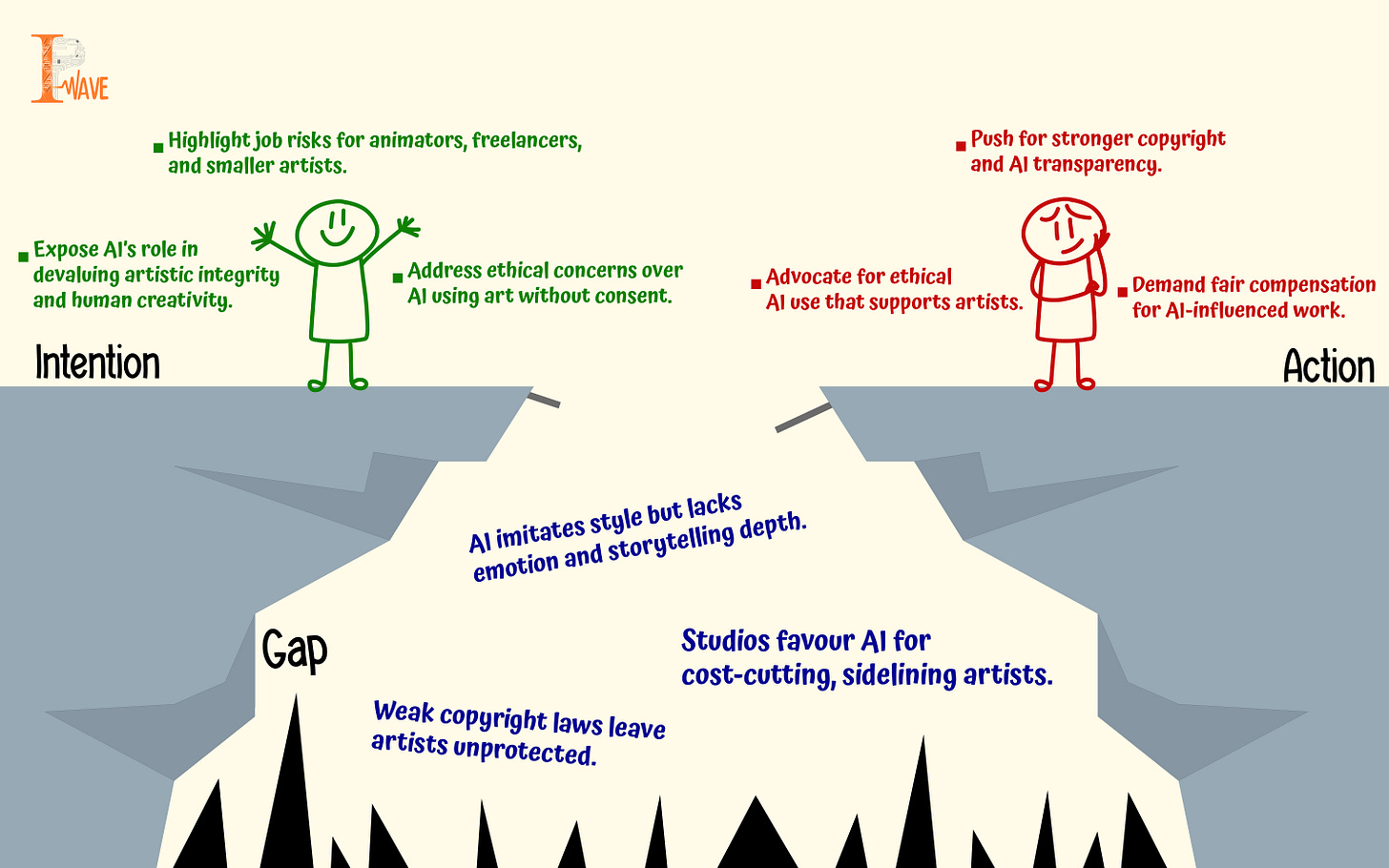AI and the Erosion of Artistic Integrity
Art is not just about what we see, it’s about what we feel. The recent trend of AI models imitating the distinct hand-drawn aesthetic of Studio Ghibli has been met with both awe and apprehension. In the present age of AI revolution, creativity has been reduced to an algorithm, and the very soul of artistic expression is being lost in the process. The rise of AI-generated art is creating an illusion of progress in the creative economy, particularly within illustration and animation. Beneath the surface, this technological shift highlights a troubling reality: AI is failing to address real creative challenges while simultaneously devaluing artistic expression and the people behind it.
AI’s potential to revolutionise industries is undeniable, yet in terms of creativity and animation, it is being directed toward superficial mimicry rather than meaningful innovation. Instead of refining workflows, enhancing accessibility, or streamlining laborious tasks without replacing artists, AI is being used to generate synthetic imitations of existing styles, as seen by the recent rising trend of Ghibli-inspired imagery. Although they may bear a resemblance to something familiar on the surface, they lack the thoughts, feelings and storytelling that contribute to artistry. The appeal of Ghibli movies isn’t only about the visuals, but the soulfulness and the storytelling woven into every frame where every other film takes about 3-4 years to be drawn with love and admiration for the craft. Miyazaki has called AI-generated work an “insult to life itself,” saying it lacks genuine human experience and feelings. This raises a critical question: Is AI genuinely advancing creative industries and adding anything of value to the industry or merely recycling pre-existing art without crediting? Instead of being a tool that assists artists or even helps them, AI is on a path to becoming a substitute, taking away the very nature of creative expression.
The problem stems from the principle of "garbage in, garbage out." AI models are only as good as their training data, so if they consume second-rate, derivative stuff, they will generate second-rate, derivative output. In contrast to human artists who develop their skills with experience and purpose, AI merely imitates patterns without comprehending them. This has already yielded visually impressive but fundamentally flawed AI-generated backgrounds in animation where the shadows are wrong, the perspectives feel awkward, and the compositions are hollow. This is corrosive to the very nature of art that gives it significance. It is not only about accuracy but also about the ability to express emotion, depth, and the human experience that, no matter how advanced artificial intelligence becomes, it will never produce.

In addition to stifling creativity, artificial intelligence is now threatening jobs throughout the industry. Once important to the visual elements of a movie, background artists and concept designers are being replaced by artificial environment-creation tools, which can churn out scenes within seconds. Netflix came under fire when, a move seen by many as a penny-pincher's trick, it chose AI-generated backgrounds for an anime project. As AI tools become more prevalent and affordable to studios seeking to cut costs, smaller artists, especially freelancers, are all the more vulnerable. Therefore, replaced not by human hands but by machines, what originally was a communal effort of animators now becomes technique coming from AI inputs and pushing creative people farther to margins.
The ethical concerns go beyond employment and into the muddy waters of intellectual property. AI models scrape vast amounts of data, often using artists’ work without permission, generating results that closely resemble copyrighted pieces but exist in a legal grey area. Current copyright laws struggle to keep up with this new reality, as ownership is difficult to define when AI merely blends pre-existing works into something “new.” Many artists have raised voices about finding their styles being replicated by AI without consent, yet there is no legal recourse to prevent it. While corporations argue that AI-generated content falls under fair use, artists often find their work being exploited without credit or compensation. The rise of AI-generated Ghibli-style art is a perfect example, as countless online platforms showcase AI creations in the studio’s signature look, yet none of these works are truly original, nor do they benefit the artists who inspired them.
The Increased reliance on AI-generated art hampers artistic integrity. What truly sets the industry apart is the storytelling and the imperfections that make human art so compelling. The shift toward AI-generated content risks reducing animation to mere efficiency-driven production, stripping away the emotional depth that defines the medium. Animation is not just about technical execution; it is about the stories it tells and the people behind them. If studios continue to favour AI-generated content over human artistry, the industry risks losing what makes it special.
The question remains: How can artists protect their work? What we need are stronger copyright laws, AI detection tools, and ethical data-use policies, but those are solutions that depend on action from artists and corporations alike. It is not fair to put all the onus on individual creators when large studios could benefit from AI advances. This would create an unfortunate dynamic where AI-generated content is monetarily prioritised at the expense of human creativity by a creative economy that enriches instead of protecting artists.
To say the AI-generated Ghibli trend is a passing trend is to ignore its magnitude; it also taps into an ongoing shift in the values we place on art. AI is a powerful tool which demands to be used with caution. The true value of Art and animation lies in the human touch, the intentional choices, the emotional depth and the storytelling that simply cannot be replicated by artificial intelligence. In the age of AI, it is not whether AI can make art but whether human society lets AI redefine the very meaning of art.

